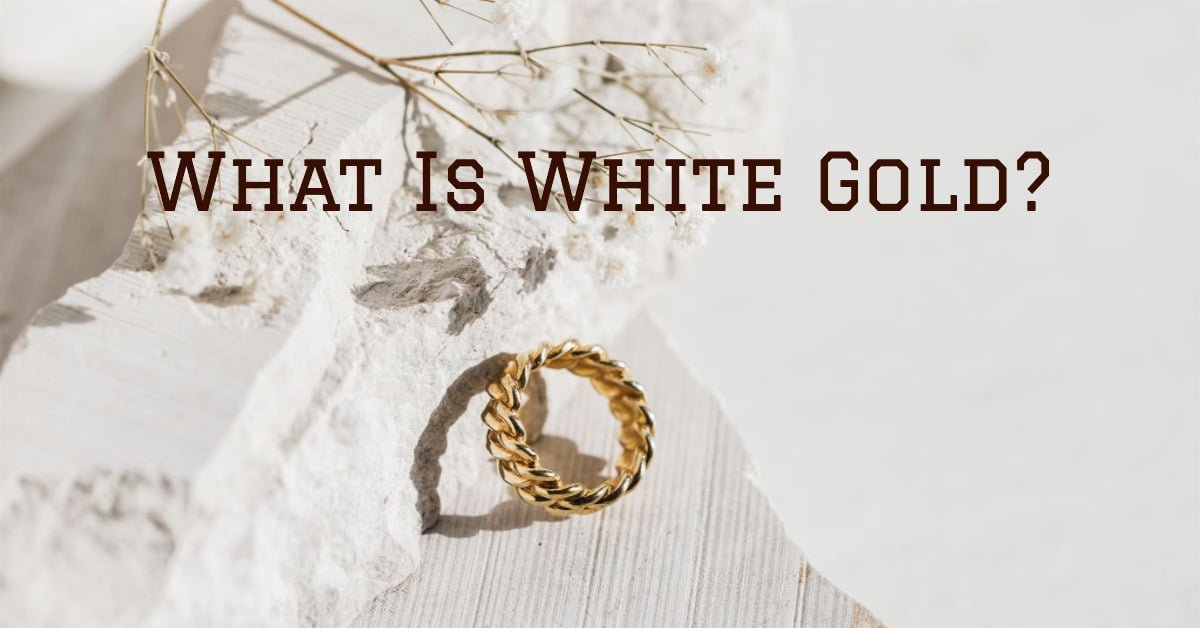White gold is a popular metal alloy used in jewelry making, known for its elegant and modern look.
It is often used in engagement rings, wedding bands, necklaces, earrings, and bracelets. But what is white gold exactly and how is it different from yellow gold?
In this section, we will explore the concept of white gold and its various forms of jewelry. We will also touch upon the differences between white gold and yellow gold and discuss the popularity of white gold engagement rings and wedding bands, particularly among women.
Key Takeaways
📚 White gold is a popular metal alloy used in jewelry making, known for its elegant and modern look.
🌟 White gold is created by combining gold with other metals like nickel, palladium, or silver, resulting in a silver or white color.
💎 Its appeal lies in its durability, resistance to tarnish and scratches, and hypoallergenic properties.
🤔 White gold engagement rings have gained popularity due to their contemporary aesthetic and versatility.
💰 The value and price of white gold jewelry vary based on factors like karat weight, craftsmanship, and market demand.
Read on to learn more about this beautiful metal.
Exploring the Allure of White Gold Jewelry
White gold is a popular material used in jewelry making, known for its unique appeal and beauty.
But what exactly is white gold, and why is it so alluring?
White gold meaning and characteristics
White gold is an alloy made by combining gold with other metals such as nickel, palladium, or silver. The resulting mixture creates a metal that has a silver or white color, hence its name. The purity of white gold is measured in karats, with 14K and 18K being the most common options for jewelry making.
One of the key characteristics that makes white gold attractive for jewelry is its durability and resistance to tarnish and scratches. Additionally, white gold is often hypoallergenic, making it a suitable option for those with sensitive skin.
White gold color properties
The distinct color of white gold is one of its most appealing features. It has a bright, silvery shine that complements a variety of gemstones and jewelry designs. White gold also has a more contemporary feel compared to traditional yellow gold, making it a popular choice for modern and elegant pieces.
“White gold has a bright, silvery shine that complements a variety of gemstones and jewelry designs.”
Understanding the Composition of White Gold
White gold is a popular metal in jewelry making due to its durability and elegant appearance. However, not everyone is familiar with its composition and how it is made.
In this section, we will explore the different metals used in white gold alloys and the process of creating white gold.

White gold is made by combining gold with other metals known as alloying metals. These metals are used to change the color and properties of the gold. The most commonly used alloying metal in white gold is nickel, but other metals such as palladium or silver can also be used.
| Alloying Metal | Percentage Used |
|---|---|
| Nickel | 25% |
| Zinc | 5% |
| Palladium | 20% |
| Silver | 15% |
| Copper | 10% |
The percentage of alloying metal used in white gold can vary, depending on the desired properties. For example, using more palladium can make the white gold more ductile and resistant to tarnishing.
The process of making white gold involves mixing the gold with the chosen alloying metal(s) and heating it to high temperatures. The mixture is then cooled and rolled into thin sheets or wires, which are used to create the jewelry pieces.
It is important to note that some people may be allergic to nickel, which is commonly used in white gold alloys. If you have sensitive skin, it may be best to opt for white gold jewelry that uses alternative alloying metals such as palladium or silver.
The Difference Between White Gold and Platinum
When it comes to selecting a metal for jewelry, two popular options are white gold and platinum. While they may look similar at first glance, there are some significant differences between the two.
Durability: Platinum is known for its durability and resistance to wear and tear. It is a much harder metal than gold, which can be easily scratched or bent.
Hypoallergenic properties: Platinum is a hypoallergenic metal, which means it is less likely to cause allergic reactions compared to white gold. This is because white gold often contains traces of nickel, which is a common allergen.
Maintenance requirements: Both white gold and platinum require regular maintenance to keep them looking their best. However, platinum requires less maintenance compared to white gold as it does not tarnish or fade over time.
Cost: Platinum is a rarer and denser metal, making it more expensive compared to white gold. This price difference should be a consideration when selecting a metal for your jewelry.
Conclusion
Both white gold and platinum have their unique characteristics and benefits. When choosing between the two, it is essential to consider factors such as durability, hypoallergenic properties, maintenance requirements, and cost to make an informed decision that suits your preferences and needs.
The Value and Price of White Gold
White gold is a popular metal for jewelry making, particularly for engagement rings and wedding bands. While its beauty and durability make it a desirable option, the value and price of white gold can vary depending on several factors.
The karat weight of white gold is one of the primary determinants of its price. The higher the karat weight, the more gold the piece contains, which typically results in a higher price. Additionally, the craftsmanship and design of the jewelry can also influence its value and price. Intricate designs or custom-made pieces may cost more due to the additional labor involved in their creation.
The market demand for white gold jewelry can also affect its price. If a particular style or design becomes popular, the demand for it may increase, resulting in a higher price point. Conversely, if demand for white gold decreases, prices may decrease as well.
When considering the value and price of white gold engagement rings and wedding bands, it’s important to note the sentimental value they hold. These pieces of jewelry often carry deep emotional significance and are symbolic of the commitment between two people. As such, their value extends beyond their price tag.
White Gold Engagement Rings
White gold engagement rings are a popular choice due to their timeless and elegant appearance. The average price for a white gold engagement ring can range from $500 to $3,000, depending on the factors mentioned above. However, custom-made or designer rings can exceed this range.
It’s worth noting that white gold engagement rings may require additional upkeep compared to other metals. Over time, the rhodium plating on white gold may wear off, causing the yellowish hue of the gold to become visible. Re-plating the ring can help maintain its bright white appearance.
White Gold Wedding Bands
Like engagement rings, white gold wedding bands are a classic and beloved choice for couples. The average cost for a white gold wedding band can range from $150 to $1,500, depending on the same factors mentioned above. Custom-made or engraved bands may cost more.
White gold wedding bands are known for their durability, hypoallergenic properties, and ability to complement various engagement ring styles. They also offer a timeless and sophisticated look that appeals to many couples.
Caring for White Gold Jewelry
White gold jewelry, particularly necklaces for women, requires special care to maintain its beauty and shine. Here are some tips to help you keep your white gold jewelry looking its best:
- Store your jewelry properly: Store your white gold jewelry in a soft cloth pouch or jewelry box to prevent scratches and avoid contact with other jewelry.
- Avoid exposing your jewelry to harsh chemicals: Remove your white gold jewelry before swimming, using perfumes, or applying lotions or hairsprays. These chemicals can cause damage or discoloration to your jewelry.
- Clean your jewelry regularly: To clean your white gold jewelry, mix a small amount of mild dish soap with warm water. Soak your jewelry in the solution for 10-15 minutes, then gently scrub it with a soft-bristled toothbrush. Rinse it thoroughly with warm water and pat it dry with a soft cloth.
- Take your jewelry for professional cleaning: It is recommended that you take your white gold jewelry for professional cleaning every six months to a year to maintain its luster and remove any buildup of dirt or grime.
- Handle your jewelry with care: Avoid tugging or pulling on your white gold necklace or bracelet, as it can cause damage or breakage. Also, be careful when adjusting the size or clasp of your jewelry to prevent warping or bending.
By following these simple tips, you can ensure that your white gold jewelry remains in excellent condition for years to come.
Exploring the Popularity of White Gold Engagement Rings
White gold engagement rings have become increasingly popular in recent years, with many couples choosing this metal over traditional yellow gold. But what makes white gold engagement rings so desirable?
One reason for their popularity is their modern and elegant aesthetic. The cool, silvery hue of white gold complements a wide variety of gemstones, allowing for endless design possibilities. Whether you prefer a classic solitaire or a more intricate setting, white gold can create a stunning and unique engagement ring.
Furthermore, white gold engagement rings are versatile in their ability to complement any skin tone or wardrobe. Unlike yellow gold, which may clash with certain colors or undertones, white gold is universally flattering and can be worn with any outfit.
Societal and cultural influences also contribute to the preference for white gold engagement rings. In recent years, white gold has become associated with contemporary luxury and sophistication, making it a popular choice for those looking for a ring that reflects their modern sensibilities.
Finally, white gold engagement rings carry a symbolic significance that is cherished by many couples. The metal’s purity and durability represent the strength and longevity of the relationship, making it a meaningful and sentimental choice for an engagement ring.
Unveiling the Beauty of White Gold Wedding Bands
White gold wedding bands are a timeless and classic choice for couples looking to exchange rings on their special day. The enduring appeal of white gold stems from its elegant and versatile aesthetic, which complements various gemstones and suits a range of styles and preferences.
When it comes to customization options, white gold offers plenty of choices. It can be engraved and adorned with diamonds, or combined with other metals to create unique and personalized designs. Some popular styles of white gold wedding bands include plain bands, eternity bands, and vintage-inspired designs.
FAQ about What is white gold?
Here are some of the most frequently asked questions about white gold jewelry:
What is white gold?
White gold is a type of alloy that is commonly used in jewelry making. It is made by mixing pure gold with one or more white metals, such as nickel, palladium, or silver, to give it a white or silver-like color.
What is the difference between white gold and yellow gold?
The main difference between white gold and yellow gold is their color. Yellow gold is naturally occurring, while white gold is a relatively new invention. Additionally, white gold is made by mixing pure gold with white metals, whereas yellow gold is made solely from pure gold.
Is white gold more valuable than yellow gold?
The value of white gold and yellow gold depends on the karat weight, which refers to the amount of pure gold present in the alloy. Both types of gold have the same value per karat, so a 14k white gold ring and a 14k yellow gold ring will have similar values.
How is white gold made?
White gold is made by alloying pure gold with one or more white metals, such as nickel, palladium, or silver. The specific combination of metals can vary depending on the desired properties of the final product. Once the metals are heated and blended, the resulting alloy is usually plated with rhodium to enhance its luster and prevent tarnishing.
Is white gold hypoallergenic?
White gold can contain nickel, which is a common allergen for many people. However, some white gold alloys are made with palladium or other hypoallergenic metals to reduce the risk of allergic reactions. It is important to check the composition of any white gold jewelry before purchasing to ensure it is safe for you to wear.
How should I care for my white gold jewelry?
To care for your white gold jewelry, avoid wearing it while doing strenuous activities or exposing it to harsh chemicals. Clean it regularly with a soft cloth and mild detergent, and store it in a separate compartment or pouch to prevent scratching. It is also recommended to have any white gold jewelry professionally cleaned and inspected periodically.
Why are white gold engagement rings so popular?
White gold engagement rings are popular because of their modern and elegant aesthetic, as well as their versatility in design. White gold also complements a wide range of gemstones, making it a popular choice for engagement rings. Additionally, cultural and societal influences have contributed to the preference for white gold in engagement rings.
Are white gold wedding bands more expensive than other types of wedding bands?
The cost of a white gold wedding band can vary depending on the karat weight, design, and craftsmanship. However, compared to other precious metals like platinum, white gold is generally less expensive. It is important to keep in mind that the value of a wedding band goes beyond its price tag, as it carries symbolic and sentimental value for the couple.
Resources and External Links
Here are some additional resources and external links that can help you understand more about White Gold:
Articles
- What is White Gold? and How It Differs from Yellow Gold – Oxford Gold Group
- What is white gold? | U.S. Geological Survey – USGS.gov
- Platinum vs. White Gold vs. Yellow Gold vs. Rose Gold – The Diamond Pro
- What is White Gold? The Only Guide You Need – Jewelry Informer
YouTube Videos
- What is White GOLD? | Jill Maurer
- 18k white gold ring – Elier Olivos
- How to alloy white gold – Jan Hendrik Viljoen
These resources provide additional information and insights about White Gold.
Disclaimer
The information provided on this website and any related content is for informational purposes only and should not be considered as financial advice. It is not intended to substitute professional financial advice, nor does it constitute a recommendation to buy, sell, or invest in any financial product or asset.
All investment decisions and actions taken by individuals based on the information provided are at their own risk. Before making any financial decisions, individuals should consult with a qualified financial advisor or professional to assess their unique financial situation, risk tolerance, and investment goals.








